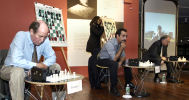


ChessBase 17 - Mega package - Edition 2024
It is the program of choice for anyone who loves the game and wants to know more about it. Start your personal success story with ChessBase and enjoy the game even more.

Imagery of Chess Revisited is on view at the Noguchi Museum from October 21, 2005 – March 5, 2006. In it the Museum recreates and expands the groundbreaking 1944 exhibition organized by Marcel Duchamp and Max Ernst at the Julien Levy Gallery. In addition to Isamu Noguchi, the exhibition features original designs by artists such as Man Ray, Arshile Gorky and Yves Tanguy. The exhibition The Imagery of Chess Revisited is supported, in part, with funds from the National Endowment for the Arts and the New York State Council on the Arts. Funding for the exhibition has also been provided by J.L. Foundation. The production and publication of the exhibition’s catalogue is made possible, in part, with funds from Dedalus Foundation.

The venue of the blindfold chess match in the museum
Imagery of Chess Revisited is a restaging of a legendary show organized during World War II by the Surrealist giants Marcel Duchamp and Max Ernst. They asked famous artists to reinvent the chess set and create work inspired by the game. Forty works have been brought together for the show.

Paul Hoffman, author, journalist and chess enthusiast, served as the master
of ceremonies, interpreting Hikaru’s efforts for the large audience of
artists and curators.

Paul Matisse, Eric Ernst (grandson of Max Ernst), and Jonathan Bayer (son of
art dealer Julian Levy) played the first three boards

Alexander Rower (Alexander Calder's grandson), Ben Schawinsky and Roger Browner
rounded out the boards
On January 6, 1945, Duchamp invited legendary blindfold master George Koltanowski to give an exhibition against six of the painters and sculptors and the art dealer Julien Levy, in whose Manhattan gallery the 1944-45 exhibition took place. Known for his theatrics, Koltanowski wore an actual blindfold and had no trouble keeping track of the games. “My mind is a gramophone record,” he once said. “When I want to know what moves have been made, I start the record in my mind. Then I listen.” He won six of the game and drew one. His all-time personal record was 34 blindfold games (he won 24 and drew 10) in Edinburgh in 1937.

Hikaru is in a nearby room, his image projected onto a screen in the playing
hall
Hikaru did better than Koltanowski against the artists, checkmating five of them and flagging the sixth. It was a clock simul, with Hikaru having 45 minutes and each of his opponents 30 minutes.

Ben Schawinsky goes into a trance after Hikaru opens 1.Nf3
Hikaru didn’t need the time. He moved almost instantaneously on each board, taxing Doug Bellizzi, the president of the Marshall Chess Club, who was relaying the moves to him by walkie-talkie. Hikaru sat in a separate room with a video camera trained on him. His image was blown up in the playing hall.

The man playing is Man Ray's nephew, Roger Browner
Occasionally his eyes rolled toward the ceiling and he looked like he was leading a séance. He did not use Koltanowski’s gramophone approach but held each position in his mind’s eye. “I want to play 12 games next time,” he said. “I had no trouble picturing all the positions except two times when I was confused for a moment about a pawn and a bishop.” The positions were confusing because most of the artists were beginners and made moves that self-respecting players would avoid.

Hoffman cautions one of the players that he is not allowed to retract
his move
Hoffman told the artists that taking one’s king for a stroll early in the game is not a wise idea. But what they lacked in chess prowess they made up for in pedigree. They were all related to the famous artists involved in the 1945 show.

The artistic pedigree of the players was strong. Here is Paul Matisse,
grandson of Henri Matisse and stepson of Marcel Duchamp
Paul Matisse (yes Matisse!), stepson of Marcel Duchamp and grandson of Henri Matisse, put up the most determined fight but lost on time. “Roger Browner, Man Ray’s nephew, pulled a classic Garry Kasparov,” Hoffman said, “by taking off his jacket when things got tough.” Hoffman told the players to try to enjoy the experience of being overpowered by the country’s strongest player.

Hikaru tell Hoffman that playing six boards was a cake walk
Ben Schawinsky, whose father had a piece in the original show, took Hoffman’s words to heart: “I’ve never been hemmed in so beautifully in my life,” he said, as Hikaru trapped his queen.

Ben Schawinsky talks about his game (all photos by Jeff Weiner)